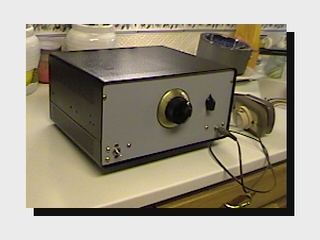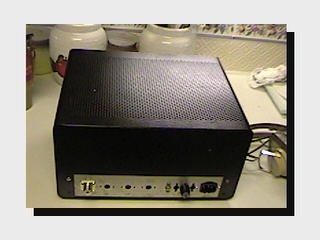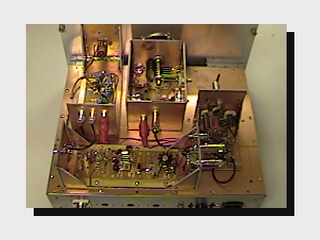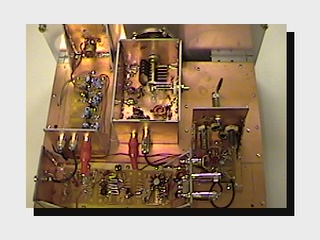

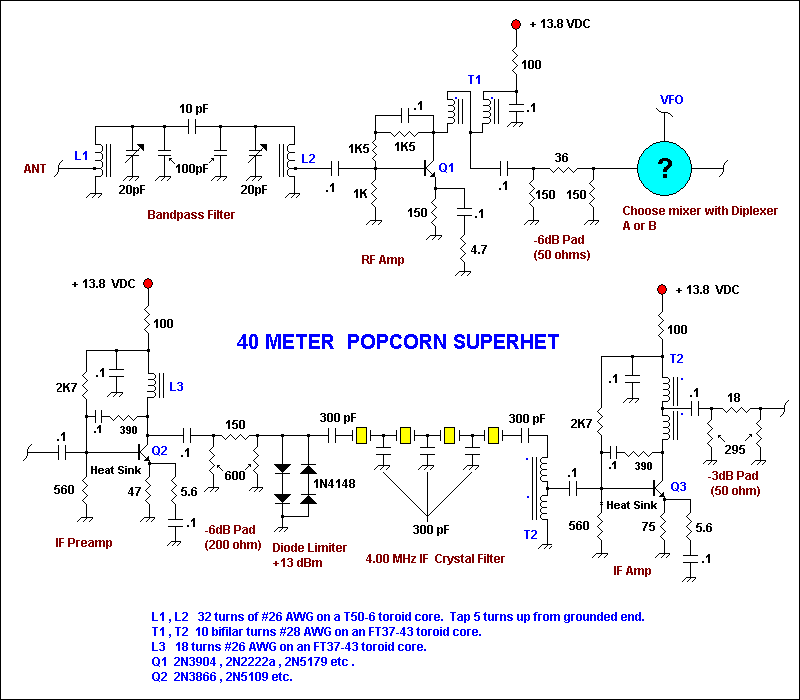
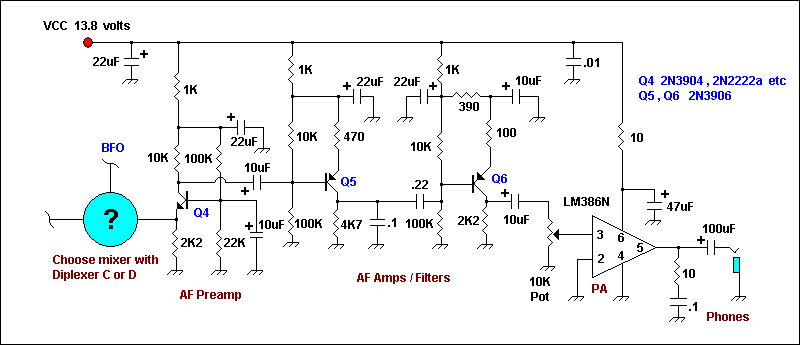
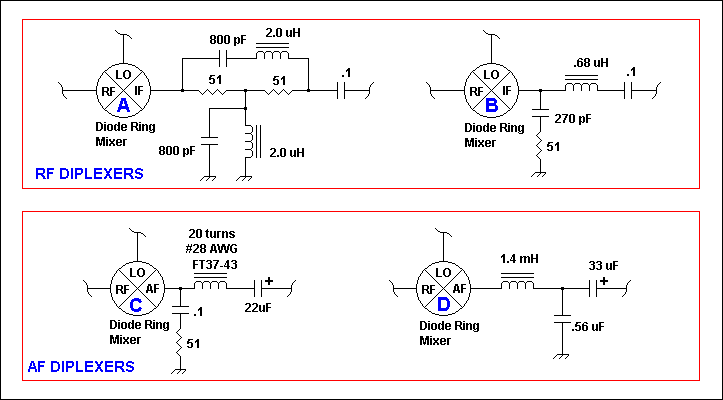
Above is the schematic for a no-frills, relatively low-cost CW superhet receiver with a 4.00 MHz Intermediate frequency. There is no AGC or RF gain control, however this receiver has good large signal handling capability. This receiver uses just 6 bipolar transistors and an op amp for reasonable volume into headphones. Much of the ideas/design of the various stages must be credited to Wes Hayward as I borrowed heavily from his previous work and through ideas obtained by discussion. If one were to homebrew the diode ring mixers, indeed this would be a very low cost receiver giving reasonable performance which outperforms any NE602 based superhet receivers that I have built or listened to. Below the main schematic is a diplexer diagram that allows the builder to choose from one of two RF and AF diplexers used to terminate the diode ring mixers.
Bandpass Filter and RF Preamp
From the 50 ohm receiver antenna jack, first off is a double-tuned bandpass filter which was designed by Rick Campbell, KK7B and works very well. The trimmer caps can be the 5 - 20 pF units sold by Digikey and Mouser. The fixed-value caps in my prototype were inexpensive
monolithic ceramic capacitors purchased from DigiKey. Rick used an NP0 ceramic for the 10 pF coupling cap plus silver-mica type for the 100 pF caps in his original design.
For possible lower insertion loss, the probable best/cheapest way would be to use
all NPO ceramics for the fixed value caps in this filter.
The RF amp is my favorite popcorn RF amp ; a 50 ohm feedback amp. A grounded-gate
JFET amp was tried in its place and was also found to be quite suitable and does not require the -6dB pi attenuator that follows the feedback amp as shown in the schematic.
The feedback amp's 50 ohm input impedance properly terminates the bandpass filter. The -6 dB attenuator pad following the amp to helps provide a 50 ohm input impedance for the mixer and to reduce stage gain which aids in preserving the signal to noise ratio of the receiver.
If a builder wants a little more sensitivity, the pi attenuation pad could be reduced to -3 dB however this may effect the receiver dynamic range.
The transformer T1 is one of 2 broadband
transmission line transformers in this receiver. It transforms the 200 ohm collector impedance to 50 ohms for the succeeding stage.
Mixer and Diplexer
A 50 ohm diode ring mixer (7dBm) such as the MiniCircuits SBL-1 or TUF-1 or homebrew
are all suitable. Following the mixer is an RF diplexer of your choice. The more complex
Reisert diplexer (A) is an excellent design, however maybe overkill in a popcorn superhet such as this.
For the (A) diplexer, to get the necessary 800 pF for the capacitors, simply parallel a 470 with a 330 pF or a 120 pF with a 680 pf capacitor. The inductors at 2.0 uH are wound on powdered-iron toroids. You can use # 26 AWG wire and it requires 22 turns on a T37-2 core or 20 turns on a T50-2 core. In addition, you can use a #6 material toroid to wind the inductors. This diplexer is described elsewhere on this web site.
The simpler (B) diplexer uses a ~3 times the IF frequency that I have seen this basic design in many textbooks and articles and provides reasonable matching with a 50 ohm inductive and capacitive reactance. The cutoff frequency chosen was 11.78 MHz as this allows the use of a standard value capacitor ( 270pF ). To wind the 0.68 uH inductor
use 13 turns on a T37-2 toroid or 12 turns on a T50-2 powdered iron torroid core.
You can easily use 24 - 26 AWG wire for the inductor.
IF Preamp , Crystal Filter and IF Amplifier
Except for the inductors, the IF preamp and IF amp are identical and both warrant a small clip-on heat sink as they draw reasonable current. The standing current maybe increased or reduced by changing the 47 and 75 ohm resistors connected to the Q2 and Q3 emitter respectively.
Factors such as available power supply current versus dynamic range requirements may come into play. One may want to stand more current in the IF preamp and less current in the IF amp. For example, the 75 ohm resistor on the Q3 emitter could be increased considerably and/or the 5.6 ohm degeneration resistor could
be increased as well if less stage current draw is wanted.
The 2N3866 transistor is usually a cheaper way to go for these amps than the 2N5109, but the choice is up to you as
you may have something available in your junk box.
The 200 ohm -6dB pad following the IF preamp should not be omitted as it helps prevents the stage from seeing reactances created ahead by the crystal filter. The four diodes form a 13dB limiter to protect the crystal filter should a catastrophically large signal be present in the receiver's front end. They maybe omitted. A -3dB 50 ohm resistive pad terminates the IF amp and helps establish a 50 ohm input impedance for the product detector ahead.
This receiver has a narrow IF Cohn Crystal filter. Bandwidth is ~ 405 hertz, which unfortunately makes
tuning quite sharp however this filter is very nice for crowded band conditions.
The IF filter crystals should be closely matched in frequency to prevent unwanted ripple in the passband.
Generally, you have to buy 10 and then if you have a frequency counter, use the receiver BFO stage to test your crystals for matching. Pick the closest 4 crystals and use them in your filter. It does not matter if the crystals have series or 20 pF load capacitance, but it does matter that they are matched in frequency within 40 hertz of one another or better for this
receiver. For my prototype receiver, I purchased ten 20 pF load capacitance 4 MHz crystals and luckily found 4 that matched each other within 9 hertz!
For those builders who do not have a frequency counter, some QRP parts retailers sell matched sets of crystals. It is important to note that the BFO should be set on the high side of the IF frequency as simple crystal ladder filters have a steeper upper passband than lower passband.
The crystal filter is terminated by the 4:1 transmission line transformer
and then 50 ohm impedance of the IF amplifier. The -3dB pad following the IF feedback amplifier helps to terminate the crystal filter by helping ensure a 50 ohm IF amp
input impedance and should not be omitted. Place a 75 and a 220 ohm resistor in series to get the required 295 ohm resistance on each leg of the pi attenuator.
Many may balk at just one stage of IF amplification, but since there is no AGC and this is
a CW receiver, it works well. A feedback amp is once again used to provide correct input and output impedances for stages connected to the IF amp. Following the IF amp is another attenuator set for -3dB and then a 50 ohm diode ring mixer.
Product Detector , AF Diplexer and Audio Amplifiers
The mixer/detector can be SBL-1 or TUF-1 types or homebrew if you want to reduce costs further as the mixers are the single most expensive components in this receiver.
Again a choice of diplexers is required. The (C) AF diplexer is very simple and maybe practical if you are trying to keep costs low. The (D) diplexer is designed by
Roy Lewellyn, W7EL and provides a 50 ohm termination for the product detector at all frequencies. This single-pole filter has a 3dB cutoff design for 5.6 KHz. This diplexer design is used by permission. The 1.4 millihenry inductor is easily wound using a single layer on a FT50-77 ferrite toroid. Wind 38 turns of #26 AWG enamel coated wire with close spacing. If the builder only has access to the more common FT37-43 ferrite core, a 1.4 mH inductor can be wound using a 26 inch piece of #30 AWG wire. To construct this inductor, cut the 30 guage wire exactly 26 inches long and place one end of the piece of wire one inch through the ferrite toroid core. Begin wrapping the core with the other end of the wire in the usual fashion, proceeding carefully around the core avoiding knots and tangles. When you reach the original end of the wire continue winding past it and proceed around the core until you have a one inch length remaining. The second winding only partially covers the core. Use fairly tight loops on each winding to avoid getting a low inductance. The one inch leads should be ample for connecting to the circuit.
The wound inductor should be cemented face down onto the PC board after removing a small portion of copper big enough to fit the inductor on so that it is not touching any of the PCB copper surface. I used a hobby tool and sanded off the copper in a circular shape about 3/4 inch in diameter. The inductor was glued on with epoxy. The Qu of these home spun audio inductors is very low and consequently have very low loss. The 0.56uF cap I used was a miniaturized metallized polyester film (DigiKey EF2564-ND) which is an expensive part at 95 cents Canadian currency.
Following the diplexer, a grounded base audio amp provides a 50 ohm termination to the product detector. AF gain and some AF filtering are provided by Q5 and Q6 which together attenuate frequencies less than 72 hertz and greater than 638 hertz. This amplifier pair are described on the discrete AF filters web page on this web site. Keep your leads short on all the AF transistors.
The final AF amp is the perennial LM386N, a low cost, easy to use AF amp. Turn it upside down and solder pins 2 and 4 right to your copper ground plane to anchor this part. There are a number of low-noise alternatives to the LM386 available which are generally more expensive but would be quite suitable. Discrete component AF amps can also be used, but a popcorn part such as the LM386N maybe cheaper and easier.
VFO and BFO
VFO schematic
BFO schematic
Construction Ideas
When constructing any project, build in small modules and test each one seperately. For instance, the AF amp should be built first and then tested by injecting a very low-level audio frequency tone into that stage and listening for output in your headphones. Every QRP workbench should have a simple AF tone oscillator from a schematic similar to the ones used for keying sidetones in CW transmitters. The encased oscillator should have to a 100K or so potentiometer connected to the output to vary the output signal amplitude. Generally use maximum resistance on the 100K pot to start with and reduce this resistance slowly as the in-test amplified oscillator output could be very loud!.
After testing the AF amp, build the 3rd AF preamp stage including the 10K panel mounted
pot so you can vary the gain going into the AF amp. Now inject the AF oscillator output
into the input on the pot and vary the 10K pot to ensure that the stage you built is working. It should be a lot louder now and should go up and down in volume with the 10K pot.
Finally build the remaining preamp stage and once again test the circuit with your AF oscillator. The output into the phones should be painfully loud now when cranked up!
The next stage to build would be the BFO. If you do not have a scope, peak the tuned circuit
by watching the S meter on a radio receiver located nearby. Ensure that you put a load on the output winding of the BFO such as 47 ohm resistor to ground. A small piece of wire can
be used as an antenna if the BFO signal is too weak to activate the S meter on your receiver. Once peaked, you can now use the BFO to match your IF crystals.
To use the BFO to match your crystals, use a small wire to bypass or disconnect
the 60 pF variable capacitor that is used to connect the crystal to ground. In other words,
the bottom lead of the crystal is connected to ground with a short piece of wire. This makes testing your crystals a little more scientific as the variable capacitor cannot influence the crystal frequency during testing.
You can also use the BFO in conjunction with a scope or voltage probe to test the various
RF amps in the receiver. I do this all the time with my scope.
Proceed with this build a stage, test a stage method and you should be rewarded with a functional end product.
KK4RF's version of the 40 Meter Band Popcorn Superhet
Marty, KK4RF emailed me and described his version of the popcorn superhet from this web page
and contributed some great info and photos of his receiver. Of note is Marty's use
of Radio Shack IC boards for mounting the components for each stage other than the VFO circuit.
This is yet another variation from ugly construction that I have also used which works extremely well. Marty built the VFO using pure ugly construction and I was glad to hear that he is enjoying good frequency stability even with the lid off the VFO enclosure.
He built the receiver into an old Heathkit HW-12 single-bander case from the 1960's and it is a very attractive receiver to say the least. He found an old National Velvet Vernier Drive at the Virginia Beach Hamfest this year and used it to tune the VFO. Don't you love Hamfests!
For the BFO he used an BFO circuit with a 4 mhz crystal from a different receiver project (a project that never quite worked.) He built a small power supply and located it along with the BFO under the chassis.
I like Marty's generous use of ground plane and neat stage layout. He reports good selectivity with his IF filter and apparently built four superhets that did not work before
building this popcorn version. This is more a testimony to Marty's perservance to home building than to this receiver design in my opinion. I won't tell you how many rig failures
I have personally incurred, as it would take a long time!
Many thanks to Marty, KK4RF for the feedback and great pictures.

